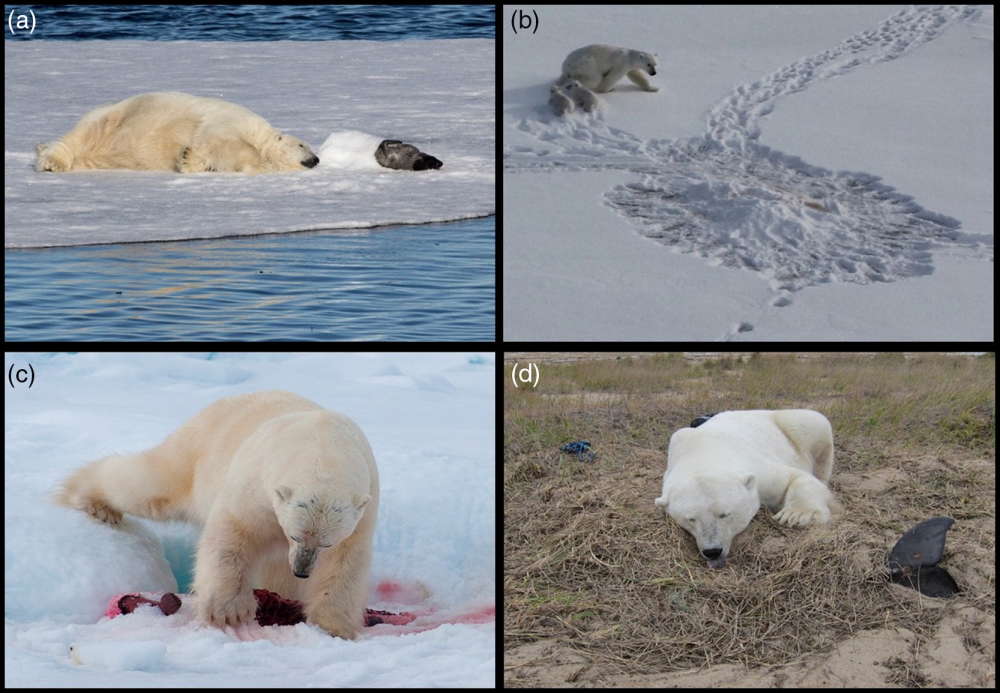北极熊观察到猎物后会埋起来,留到以后再吃
北极熊观察到猎物后会埋起来,留到以后再吃
Within the Arctic Circle, every now and then, the largest of all bear species hides a hard-earned kill in an icy larder. Just like a squirrel buries its nuts to save for later, polar bears have been observed burying meaty carcasses under the snow. A new study, published in Arctic Science, explores this behavior, finding that while it does occur, it is still pretty rare.
在北极圈内,北极熊是所有熊类中最大的一种,时不时地会在冰里藏起一只来之不易的猎物。就像松鼠会把坚果埋起来以备以后吃一样,北极熊也会把猎物的尸体埋在雪下。发表在《北极科学》杂志上的一项新研究探讨了这种行为,发现尽管它确实发生了,但仍然相当罕见。
A team led by the University of Alberta set out to determine whether polar bears exhibit caching behavior and how frequently it had been observed. To find out, they trawled through thousands of observations of bears made in Svalbard, Greenland, and Canada between 1973 and 2018.
由阿尔伯塔大学领导的一个研究小组开始研究北极熊是否有贮藏食物的行为,以及观察到这种行为的频率。为了找到答案,他们查阅了1973年至2018年间在斯瓦尔巴特群岛、格陵兰岛和加拿大观察到的数千只熊。
“The paucity of observations of wild polar bears (Ursus maritimus) caching of food (including hoarding, i.e., burying and remaining with a kill for up to a few days) has led to the conclusion that such behavior does not occur or is negligible in this species,” the researchers begin their paper. However, they identified 19 instances of polar bears hiding their food, suggesting that although rare, this behavior is very much present in the species.
野生北极熊贮藏食物(包括囤积食物,即不食用动物)的观察很少。研究人员在论文的开头写道:“在美国,将尸体掩埋,并将其与猎物一起保持几天时间)导致了这样一个结论:这种行为不会发生,或者在这个物种中是微不足道的。”然而,他们发现了19个北极熊藏食物的例子,这表明虽然这种行为很罕见,但在这个物种中却非常普遍。
“My curiosity about short-term food caching was re-activated by receiving a photo from a friend of a male polar bear lying on the ice with a mostly snow-covered harp seal [image a below],” study leader Dr Ian Stirling told Polar Bears International. “I had seen this kind of behavior only once in over 40 years of research on polar bears. On talking with colleagues… all had seen this behavior, but only rarely.”
研究负责人伊恩·斯特灵博士告诉《北极熊国际》杂志:“我收到了一张朋友的照片,照片上是一只雄性北极熊躺在冰面上,旁边是一只几乎被雪覆盖的格陵兰海豹,这再次激发了我对储存短期食物的好奇心。”“在40多年对北极熊的研究中,我只见过这种行为一次。在与同事交谈时……所有人都看到过这种行为,但非常罕见。”

Examples of polar bears keeping their snacks a secret from other bears. Stirling et al. 2019/Arctic Science
It appears that hoarding behavior is influenced by features of the prey. A small snack, like a baby seal, will be gobbled down in one, leaving nothing to hoard, but a larger meal, like an adult ringed seal or part of a whale might be covered in snow and guarded by the bear while it takes a break from eating. The researchers think this is to prevent a phenomenon known as kleptoparasitism, which involves fellow bears and other scavengers getting their paws on the prize and stealing it.
囤积行为似乎受到猎物特征的影响。小猎物,比如小海豹,会被一口吞下,什么也不剩,但大点的食物,比如成年环斑海豹或鲸鱼的一部分,可能会被雪覆盖,在熊休息的时候由它看守。研究人员认为,这是为了防止一种被称为“盗窃寄生虫症”的现象,这种疾病会让熊同胞和其他食腐动物把爪子伸向奖品并偷走。
The sight of a dark, bloodied carcass is quite an obvious one in a pristine white backdrop, so a covering of snow makes the kill much harder for other animals to spot. They might still be drawn to it by its smell, though. The authors note that bears are more likely to cache their prey when there’s more snow about to cover it. Some polar bears were so keen to cling onto their prey, they were observed burying it multiple times.
在原始的白色背景下,看到一具黑色、血迹斑斑的尸体是相当明显的,因此覆盖的雪使得其他动物很难发现被猎杀的动物。尽管如此,他们还是会被它的气味所吸引。作者指出,当雪越积越多的时候,熊就越有可能隐藏它们的猎物。有些北极熊非常喜欢抓住猎物不放,有人看到它们把猎物埋了好几次。
“When the ship was about 150 meters from the bear, it woke, dragged the carcass out from under its snow covering, left the floe he was on, swam with it to an adjacent floe, and dragged it out of the water,” notes the paper, describing one observation. “Between about 19.30 and 22.30 the bear moved the carcass several times, each time after which he slept briefly, washed his paws, fed, and re-buried the carcass.”
“当船离熊大约150米的时候,它醒了,把尸体从积雪下拖出来,离开他所在的浮冰,游到附近的浮冰上,把它从水里拖出来,”这篇论文描述了一个观察结果。“大约在19点30分到22点30分之间,这只熊移动了几次尸体,每一次之后它都会短暂地睡上一觉,洗一洗爪子,吃点东西,然后再把尸体埋起来。”
Another bear was sighted with an entire beluga whale calf (it probably found it dead), which it dragged off the beach and covered with grass. One bear was even seen with a half-eaten young polar bear, which it had partially covered with seaweed.
另一只熊被发现和一整只白鲸幼崽在一起(它可能发现幼鲸已经死了),它把幼鲸拖出海滩,用草覆盖着。有人甚至看到一只熊和一只吃了一半的小北极熊在一起,北极熊身上有一部分被海藻覆盖着。
Caching behaviour has been observed in various bear species, but it’s most common in brown (aka grizzly) bears. The researchers believe that the difference in caching frequency between the two species might be linked to who they share their habitat with. Brown bears have a denser population, and share their forested homes with numerous scavengers like wolves and ravens. Polar bears, meanwhile, are more spread out and only have to deal with the occasional Arctic fox or feathered thief. Nevertheless, when you’re in possession of a whale carcass or a big juicy seal, keeping it secret is always a good idea.
缓存行为在各种熊类中都有发现,但最常见的是棕熊(灰熊)。研究人员认为,这两个物种缓存频率的差异可能与它们与谁共享栖息地有关。棕熊的种群密度更大,它们与许多像狼和渡鸦这样的食腐动物共同生活在森林里。与此同时,北极熊更加分散,只需要对付偶尔出现的北极狐或长有羽毛的小偷。然而,当你拥有一具鲸鱼尸体或一只大而多汁的海豹时,保守秘密总是一个好主意。
- 频道推荐
- |
- 全站推荐
- 推荐下载
- 网站推荐


















